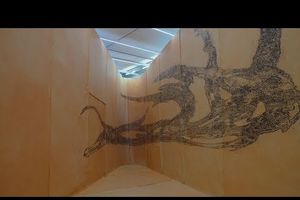
MAJA BOJANIĆ IN BRIN ŽVAN: BREZIZHODNA PRIZADEVANJA / STRUGGLES BEYOND REPAIR
Sodobna umetnost (Aljoša Abrahamsberg),
23. december 2025
― Struggles Beyond Repair (Brezizhodna prizadevanja) sledi dogajanju v ozadju delovanja Inštituta za zaščito plesni. Fiktivna nevladna organizacija je od ustanovitve leta 2022 osrednje raziskovalno telo za proučevanje plesni v javnih ustanovah, ki utemeljuje trajnostni postrestavratorski model in pionirsko razvija alternativne smernice na področju naravne in kulturne dediščine. Leta 2025 se inštitut sooča z možnostjo propada zaradi številnih – materialnih, etičnih in administrativnih – kriz, ki bi lahko prekinile njegovo nadaljnje delovanje. V razširjeni videoigri Struggles Beyond Repair se ob koncu navidez vsakdanjega delavnika znajdemo v osamelih in od zunanjosti izoliranih prostorih inštituta, popolnoma prilagojenih delovnim, raziskovalnim in razvojnim procesom, ki se v njih izvajajo. A med vohljanjem po datotekah in predalih se postopoma dokopljemo do zatohlega zaledja, v katerem ozračje nerešljivih problemov in nevzdržnih pogojev izčrpava tudi osrednji predmet raziskav, okoli katerega se je inštitut sploh vzpostavil: plesen Stachybotrys chartarum. Medtem ko so idejni in materialni temelji inštituta očitno načeti, organizacija lastnemu razkroju kljubuje z ritualističnim vzdrževanjem delovnih postopkov, nenehno usmerjenih k iskanju rešitev, ki bi odložile soočenje z razpadom. Kot spekulativna kondenzacija institucionalnih mehanizmov poznega kapitalizma na pragu grozeče podnebne prihodnosti inštitut deluje kot aparat, ki s potrebo po skrbi in upravljanju ohranja predvsem lasten obstoj. Med igranjem težko ubežimo slutnji, da smo tudi same_ postale_ del živih in obrobnih podpornih struktur, ki morajo delati dalje in proizvajati vtis nemotenega delovanja za utemeljitev inštituta tudi po izčrpanju njegovega poslanstva. Ključni odpor se tako oblikuje na molekularni ravni, ki prehaja med razpokami izčrpanega sistema, ko plesen, ki je bila nekoč predmet raziskav, dokončno uveljavi svoj model obstoja: trajnost kot počasno, a neizbežno vztrajanje razkroja … Maja Burja kurato













